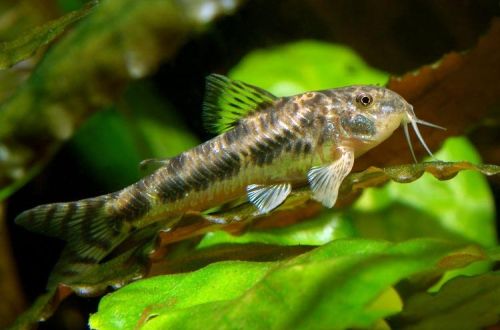
Barbus cozuatis
Barbus cosuatis, scientific name Oreichthys cosuatis, belongs to the family Cyprinidae (Cyprinidae). A miniature schooling fish that will make a good addition to a community of other peaceful fish. Relatively easy to keep and breed, it can be recommended for beginner aquarists.

Contents
Habitat
The fish is native to South Asia. The natural habitat extends to the vast basins of the Ganges and Brahmaputra rivers in the territory of the modern states of Nepal, India and Bangladesh. Inhabits small tributaries with clear water and dense coastal and overhanging vegetation.
Brief information:
- The volume of the aquarium – from 60 liters.
- Temperature – 23-28°C
- Value pH — 6.0–7.0
- Water hardness – soft (1-10 dGH)
- Substrate type – soft sandy
- Lighting – subdued
- Brackish water – no
- Water movement is weak
- The size of the fish is about 4.5 cm.
- Feeding – any food of suitable size
- Temperament – peaceful
- Keeping in a group of 6-8 individuals
Description
Adults reach a length of about 4 cm. The fish have a large head with large eyes and a stocky body. The coloration is silvery with black strokes at the base of each scale. On the enlarged dorsal fin, yellow shades and a black ornament of irregularly shaped spots appear. Males, unlike females, are larger and look more colorful, there is a black spot on the anal fin, and the ventral fins are colored red.
Often, under the name Barbus cozuatis, another related species, Barbus oreichthys, is mistakenly supplied, which has a more variegated color and a sail-like dorsal fin.
Food
Omnivorous species. The diet and composition of the feed directly affects the color, so it is desirable that the products contain a large amount of protein. It is recommended to feed live or frozen brine shrimp, bloodworms, daphnia, etc. on a regular basis.
Maintenance and care, arrangement of the aquarium
The optimal size of the aquarium for a flock of 6-8 individuals starts from 60 liters. The design uses a soft sandy substrate, thickets of aquatic plants, including floating ones for additional shading, various snags and other decorative elements suitable as a shelter. Subdued lighting emphasizes the color of the fish. In bright light, the color becomes faded.
A useful addition will be the leaves of some trees, placed at the bottom. They not only give the design more naturalness, but also give the water a composition characteristic of natural reservoirs due to the release of tannins during the decomposition process. Read more in the article “Which tree leaves can be used in an aquarium.”
The content of Barbus cozuatis consists of standard aquarium maintenance procedures: equipment maintenance, weekly replacement of part of the water with fresh water, removal of organic waste (food residues, excrement).
Behavior and Compatibility
Peaceful schooling fish. It is necessary to maintain the number of flocks of at least 6-8 individuals. With fewer Barbus cozuatis can become overly shy. It is worth avoiding joint keeping with large and especially predatory species. As compatible fish, you can use other barbs of comparable size, zebrafish, rasbor, cory catfish, small tetras and others.
Breeding / breeding
Under favorable conditions, spawning can occur regularly. However, the survival rate of fry in a community tank will be low due to predation by adult fish and feeding problems – it is difficult to provide suitable food.
If breeding is planned, then a separate tank should be prepared in advance, in some cases a three-liter jar will do. This makeshift spawning aquarium is equipped with a simple airlift filter with a sponge and a heater, no separate light source is required. As decoration, either artificial spawning vegetation, or unpretentious mosses and ferns, shade-loving aquatic plants are used.
With the onset of the mating season, the fish lay eggs on the lower surface of the leaves of plants. Since the parental instincts are not developed in Barbs cozuatis, immediately after the end of spawning, they can eat their own masonry. Until they do, the eggs are carefully transferred to a pre-prepared spawning aquarium with identical water conditions. The incubation period lasts about 3 days. For another 5 days, the fry that have appeared will feed on the remains of the egg yolk, after which they will begin to swim freely in search of food. In the initial period, they will need microscopic food, such as shoe ciliates, only after a week they will be able to eat powdered food, Artemia nauplii and other products.
Fish diseases
In a balanced aquarium ecosystem with species-specific conditions, diseases rarely occur. Diseases are caused by environmental degradation, contact with sick fish, and injuries. If this could not be avoided, then more about the symptoms and methods of treatment in the section “Diseases of aquarium fish”.





